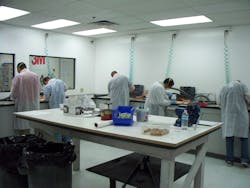In training entry-level composites technicians the challenge is to instill good habits; in bringing on experienced workers the trick is to break some already ingrained habits, habits that have been rendered bad with the advent of new technology.
Consider for a moment ply orientation and proper cure cycles, critical items when it comes to getting the most out of a composite repair. “In the past…equipment wasn’t as smart as it is today,” says Louis C. Dorworth, division manager for direct services at Abaris Training Resources, Reno, NV. Dorworth’s knowledge base goes back a bit, to a time when analog technology reigned. He was on the ground floor for the flowering of the digital era. Back then he says – partially as a consequence of that relative technology deficit – “We had less information about repairs. Therefore, we had the risk of having a repair that didn’t perform well.” Resins and fiber orientation are good cases-in-point. Their properties “may not have been as well monitored” as they are today.
Among the habits that have to be trained into older technicians:
- Exact fiber orientation. The Abaris official says it’s critical fibers be “oriented on axis at each level of the repair … so that it’s aligned with each layer of the structure.” In the past he contends the mindset was, ‘It doesn’t matter if it’s off five degrees or 10 degrees … just get close.’ That attitude won’t fly, not anymore. “You want to be right on the money … within a couple of degrees. And there’s a lot of care taken to make sure that happens;”
- Ensuring the cure. Dorworth says the old analog gear, the past tense approach, employed just one or two thermocouples. “They’d be monitoring selected sites on the repair area,” sites “where the data may or may not be accurate.” If the technician used heat lamps, some areas might be hot, others not. Afterall, “Getting the full temperature across the entire repair” is the ultimate aim. That means deploying more thermocouples, something some experienced hands may not be accustomed to doing;
- Mixing the resins right. Dorworth says if you’re dealing with a wet resin repair, it takes more “care, detail and accuracy” to ensure the mix is right.
The Metal Mindset
Some older technicians aren’t the only folks with habits which no longer work well. Take metal workers, young or old. “A good metal guy,” uses a die grinder in a fundamentally different way that a good composites technician. They “go in with the leading edge,” says Dorworth. As a consequence “they tend to really take off a lot of material with each pass. Well, if you take that same approach with that same tool to a composite you’ll dig into that composite and destroy it within seconds.”
Good composite training courses are especially keen to make this distinction, stressing the importance of working with the trailing edge of the die grinder so as to delicately “feather” the materials. In this case, at Abaris, the introductory learning material is plywood.
That basic skill imparted, Dorworth says the metal guys are “ready to move on to the next level,” to feather around the damage removal area of the actual composite structure. Results come surprisingly quickly. “Over a couple of days of practice these guys [progress] from a pretty poor scarf angle of removal to a very well done [one].”
Why so fast? Remember, these people are A&Ps, die grinders are far from alien to them. Dorworth says, “They’re just having to learn how to [work with it] “in a different manner.”
Overall, the Abaris executive says, “There are plenty of old dogs who are willing to learn new tricks.”
Taking It from The Beginning
Getting younger composites students to train up on next-generation digital gear “is the easy part,” says Dorworth. “Getting them to actually be competent with their hands is our biggest challenge.” Teaching them the basics of measuring and using calipers, employing a 12-inch scale to lay out a grid, getting them to measure out ply locations, “those are the kinds of things that they’re lacking,” he says. “It goes back to our school system…Kids are coming out of school without basic skills to do those kinds of things.”
Enter the technical college, places such as South Seattle College and Wisconsin Indianhead Technical College.
Dorworth says South Seattle has a one-year STEM-Bridge program that focuses on science, technology, engineering, and math). The effort lays out the technical foundation upon which composites careers are constructed. “They become competent in all these basic skills.” Students also get “a basic understanding of composite materials” such that they’re able to enter into composites training entities such as Abaris “at a higher level … without us having to teach them all the basics.”
Across the country at Wisconsin Indianhead Technical College (WITC) in northwestern Wisconsin, they’re innovating too. While South Seattle College serves to help funnel graduates, ultimately, to aerospace firms in the Pacific Northwest, WITC’s composites effort was initially started to support start-up Kestrel Aircraft, says Dave Crockett, head of WITC’s composite technology program. He says, “The program quickly expanded to support Cirrus Aircraft” as well as MRO giant AAR, both in Duluth.
WITC teaches the basics of composite fabrication and repair for aircraft, wind turbine blades, and boats. In that sense, it’s a generalist. “What the aircraft industry uses for repair procedures is actually very similar to what the wind turbine guys do,” says Crockett. “So, my students know how to repair aircraft … repair a wind turbine blade or a marine hull.”
WITC can be as flexible as it needs to in its expanding composites curriculum. But what students are there for are jobs. And that means training aspiring technicians to specialize, specifically in aircraft. For example, nearby Cirrus has “very specific repair procedures, per their SRMs.” WITC teaches would-be composite technicians how to read the OEM’s specific structural repair manuals.
That flexibility extends to the kinds of courses and certifications WITC offers. Crockett says WITC recently received approval for a curriculum that meets a number of needs, both those of industry and students. The previous program provided just a two-year associates degree.
“Because we realize some students don’t want a full two-year associate degree, we now break the program in to an associates degree, the technical degree,” says Crockett. “And then we hand out certifications. Students just want to come and learn [repair], they get what we would call a ‘repair certification.’ They take one semester of courses. And if they want to get a ‘fabrication certification,’ then they take two semesters. Fabrication actually includes a repair certification.”
As with the composites themselves the hands-on, structured course work itself is layered.
How’s the industry reacting to WITC’s multi-level approach?
“Very favorably,” asserts Crockett. “All students of our recent graduating class were hired by a local aircraft company and AAR.”
Some composites graduates are being hired “right off the bat.” Other are working first as interns. So satisfied has AAR been that Crockett says the MRO is “now funding half of our marketing costs for our composites program. That’s how interested they are in it.”





